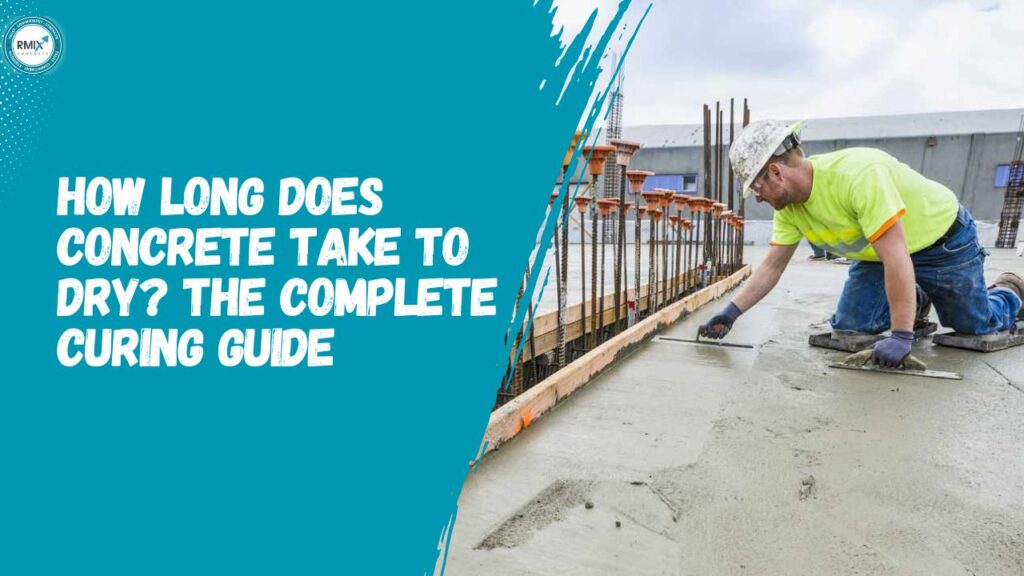
How Long Does Concrete Take to Dry? The Complete Curing Guide
Concrete is one of the most widely used materials in construction. Whether you’re building a foundation, driveway, or patio, knowing how long concrete takes to dry is essential for getting strong, durable, and long-lasting results. Many people assume concrete dries quickly after pouring, but in reality, it goes through a gradual process known as curing, which can take days or even weeks.
In this complete guide, we’ll explain how long ready mix concrete takes to dry, what affects its curing time, and how to ensure your concrete sets properly for maximum strength and durability.
Understanding Concrete Drying vs. Curing
Before we talk about timing, it’s important to understand that drying and curing are not the same things.
- Drying means the moisture in the concrete surface evaporates, making it feel dry to the touch.
- Curing, on the other hand, is a chemical process in which cement reacts with water to gain strength and hardness over time.
Even if concrete looks dry after a day or two, it’s still curing beneath the surface. Proper curing ensures that the concrete achieves its maximum strength, minimizes cracks, and lasts for decades.
How Long Does Concrete Take to Dry?
Concrete drying or curing time depends on several factors such as temperature, humidity, and the mix ratio. Generally:
- After 24–48 hours: The concrete surface becomes hard enough to walk on.
- After 7 days: The concrete gains about 70% of its strength.
- After 28 days: The concrete is considered fully cured and ready for heavy use or load.
So, the simple answer is concrete takes around 28 days to fully cure, though you can walk on it safely after about 48 hours.
Stages of Concrete Curing
Let’s look at the three key stages of concrete curing:
1. Initial Setting (0–24 Hours):
- The concrete starts to harden after mixing with water.
- This is the most crucial stage; avoid walking or applying any pressure.
- Keep the surface moist to prevent early cracks.
2. Intermediate Curing (1–7 Days):
- Concrete gains around 50–70% of its strength.
- It’s safe to walk on but not yet ready for heavy loads.
- Continue curing by keeping the surface wet or covered.
3. Final Curing (7–28 Days):
- The chemical reaction between water and cement continues.
- After 28 days, concrete reaches its full strength.
- You can now drive vehicles, install structures, or paint it.
Factors That Affect Concrete Drying Time
Concrete doesn’t dry at the same rate everywhere. Here are some important factors that can speed up or slow down the curing process:
1. Temperature
Concrete cures faster in warm temperatures (around 25–30°C). In cold weather, the process slows down because the chemical reactions happen more slowly.
2. Humidity
High humidity means more moisture in the air, which slows drying. In dry climates, concrete may dry too fast, causing surface cracks if not properly cured.
3. Water-to-Cement Ratio
If too much water is added during mixing, the concrete will take longer to dry and may become weaker. Always follow the correct water ratio recommended for your mix.
4. Type of Cement
Different types of cement set at different speeds. For example, rapid-hardening cement cures faster than ordinary Portland cement.
5. Mix Design and Additives
Using additives like accelerators or retarders can change curing time. Accelerators help in faster setting, while retarders delay it.
6. Surface Thickness
Thicker concrete slabs take more time to cure as the moisture inside needs longer to evaporate.
Tips for Proper Concrete Curing
Proper curing is essential to ensure that your concrete structure lasts longer and remains crack-free. Here are some expert tips to get the best results:
-
Keep the Concrete Moist:
Spray water on the surface regularly or cover it with wet burlap or plastic sheets for at least 7 days. -
Avoid Extreme Temperatures:
Don’t pour concrete during very hot or cold weather. Use curing compounds if needed. -
Use Curing Compounds:
Applying a curing compound forms a protective layer that prevents moisture loss. -
Protect from Wind and Sun:
Direct sunlight or strong wind can cause rapid drying, leading to cracks. -
Check for Cracks Regularly:
Early detection helps fix small issues before they become bigger problems.
How to Know If Your Concrete Is Fully Cured
Here are a few ways to know whether your concrete has cured properly:
- Color Change: The concrete changes from dark to light grey as it dries.
- Hardness: Try pressing a nail or key into the surface — if it doesn’t leave a mark, it’s hardened well.
- Time Frame: If 28 days have passed under normal conditions, the concrete is usually fully cured.
Can You Speed Up the Drying Process?
Yes, but carefully! Here’s how you can speed up concrete curing without affecting quality:
- Use fast-setting cement or curing accelerators.
- Maintain proper temperature and ventilation.
- Reduce water content in the mix (but don’t overdo it).
- Use dehumidifiers in enclosed areas.
However, never force-dry concrete using heat — it can cause surface cracks and weaken the structure.
Common Mistakes to Avoid
Many construction issues arise due to improper curing. Avoid these common mistakes:
- Walking or driving on concrete too early.
- Not keeping the surface moist during the first few days.
- Adding too much water during mixing.
- Pouring in extreme weather conditions.
Proper care in the early stages ensures your concrete remains strong for years.
Final Thoughts
Concrete may look simple, but its strength depends heavily on proper drying and curing. While it’s safe to walk on after 48 hours, remember that full strength takes around 28 days. Patience during this period ensures a durable and long-lasting structure.
By following the right curing methods and maintaining ideal conditions, you can prevent cracks, improve strength, and make your concrete surface stand the test of time.
FAQs
1. How Long Does Concrete Take to Dry Completely?
Concrete generally takes around 28 days to fully cure and reach its maximum strength. However, it may feel dry to the touch within 24 to 48 hours.
2. When Can I Walk on Newly Poured Concrete?
You can safely walk on new concrete after 24–48 hours, but avoid placing heavy objects or vehicles on it for at least 7 days.
3. How Long Before I Can Drive on Concrete?
Light vehicles can drive on concrete after 7–10 days, while heavy vehicles should wait for the full 28-day curing period.
4. What’s the Difference Between Drying and Curing Concrete?
Drying means moisture evaporates from the surface, while curing is the chemical process where cement reacts with water to gain strength and hardness. Curing is more important for long-term durability.
5. Can Rain Damage Concrete While it’s Drying?
Yes. Rain within the first 12 hours can weaken the surface or wash away cement. It’s best to cover concrete with plastic sheeting if rain is expected.
6. How Can I Make Concrete Dry Faster?
You can use fast-setting cement, curing accelerators, or maintain a warm and dry environment. However, avoid using direct heat as it can cause cracks.
7. What Happens if Concrete Dries too Fast?
Rapid drying leads to surface cracks and weak bonding. Keeping the concrete moist during the first 7 days helps prevent this issue.
8. How Long Should I Keep Concrete Moist for Curing?
Keep concrete continuously moist for at least 7 days for normal cement and 3 days for rapid-hardening cement.
9. Can I Paint or Seal Concrete Before it’s Fully Cured?
No. Always wait for the full 28 days before painting, sealing, or polishing your concrete surface to ensure proper bonding.
10. Does the Weather Affect Concrete Drying Time?
Absolutely. Hot weather speeds up drying, while cold or humid conditions slow down the curing process. Ideal curing temperatures are between 10°C and 30°C.
11. Why is Curing important for Concrete?
Proper curing ensures the concrete develops full strength, reduces cracking, and increases its durability and lifespan.
12. Can I Use Water to Help Concrete Cure?
Yes. Sprinkling water or covering the surface with wet burlap or plastic sheets helps maintain moisture for better curing.
13. How Thick Concrete Affects Drying Time?
Thicker slabs take longer to cure because moisture takes more time to escape from deep inside. Always allow extra curing time for thick sections.
14. Is it okay to Pour Concrete in Winter?
Yes, but you need to use winter-grade additives and ensure the temperature stays above 5°C to prevent freezing during curing.
15. What are the Signs that Concrete is Fully Cured?
Fully cured concrete appears light grey, feels solid, and resists indentation when pressed. It’s also past the 28-day curing mark.
Note :- Use our RMC Calculator to quickly estimate the right amount of Ready Mix Concrete for your project. Visit – https://rmix.in/rmc-calculator/












